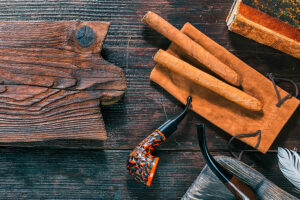What is the difference between pipe smoking and cigar smoking? In some ways, it’s like comparing apples to oranges, and in many ways, they both offer the same tobacco enjoyment. It’s not hard to find cigar shops that carry pipes and pipe tobacco.
That’s because pipe smoking still has a large following, although it’s less popular than it was decades ago, especially among the younger, post-baby boom generation who normally prefer cigars.
From the turn of the 20th century up to the early 1960s when pipe smoking was at its peak of popularity, pipe smoking wasn’t only an enjoyable hobby, but it also made a fashion statement. It was quite common for a gentleman to purchase a pipe that complimented his facial structure, wardrobe, height, and body frame.
In fact, many pipe shops in those days had a mirror above their pipe display cases so patrons could see which pipe suited their look and style. Along with comfort in the mouth, fashion was one of the many reasons why there are a staggering array of pipe shapes and sizes to choose from.
Modern smokers today have little regard for how a pipe suits their appearance. Perhaps that’s why contemporary smokers turn to cigars when they reach smoking age. Or just maybe they look at pipe smoking as the stereotype of the nerdy professor in a tweed jacket and bowtie that they have no desire to emulate.
Once considered cool, debonair, and attractive to the lady fair, it seems that pipe smoking has completely gone out of style in some people’s minds. That should never dissuade you, because there are plenty of knowledgeable groups on social media, of all ages, that can give you great tips on pipe smoking, choosing a pipe, and reviews of the many styles of pipe tobacco on the market today.
Pipes vs. Cigars
The big difference between pipe and cigar smoking is how the tobacco is delivered to the palate. To enjoy a cigar, you simply need to cut it, light it, and flick the ash from time to time. Pipe smoking requires more maintenance and hardware than cigar smoking.
First and foremost, you have to get at least one pipe, preferably more if you plan on smoking it every day. Owning just a single pipe and smoking it consistently is a great way to burn through the bowl and render it useless.
Most pipes can’t handle too much excessive heat and need to cool down and rest. Therefore, It’s a good idea to have at least three pipes in your collection to rotate them every other day. You will also need pipe cleaners, some type of pipe tool that has a tamper to tap down the bowl, and a special tool to remove excess tobacco dottle off the side of the bowl, so it doesn’t eventually crack.
Note: You should always leave at least a layer of dottle (built-up leftover tobacco) about the size of a side of a nickel inside the edges of the bowl so that the pipe always smokes smooth and cool.
Types of Pipes
Most pipes designed for smoking tobacco are made of briar, corncob, or meerschaum, and to a lesser extent, clay, olivewood maple, mesquite, oak, and bogwood. With a lot of choices to choose from, Briar is the most traditional and common material used for making pipes.
Briar is composed of the burlwood found at the base of the heath tree, which grows in the Mediterranean Sea region. Areas that are most known for briar production are Italy, Spain, The Corsica Island of France, and Algeria.
The burl grows underground, between the root and the trunk of the tree in mountainous regions of the above countries. The higher up the mountain that the briar grows, the older, more porous, and costlier to the consumer it will be. Briar Pipes are priced according to grain, which is most desirable for the serious collector, but will not affect the quality or taste.
If you are just starting out in the hobby, and not particular about grain, you can easily find a great, smoking pipe for around $20 or $30. Corncob is very inexpensive, disposable, and provides accurate tobacco flavors once broken in.
Meerschaum is composed of the fossilized remains of microscopic sea creatures that died and came to rest on the seafloor. Meerschaum is mostly found in Turkey where expert pipe makers often carve intricate designs on each bowl. If you delve deeper into the pipe smoking hobby, Meerschaum is a luxurious way to flaunt your love of pipe smoking.
Pipe Smoking Experience
Once you’ve purchased a pipe, it’s a matter of deciding on what kind of tobacco to smoke. Many will begin with a mellow aromatic blend that is made of Virginia, Black Cavendish, and Burley tobacco that is seasoned with various casings such as cherry, vanilla, chocolate, bourbon, and other exotic flavorings.
Those that prefer an earthier, spicier, and bolder nonaromatic experience, may move onto English blends that consist of stronger tobaccos that utilize Syrian latakia, Louisiana Perique, and occasionally some Oriental tobacco varietals such as Xanthi, Byzantium, Izmir, and more. A whole new discussion can be written about the complexity and style of English tobacco blends, but we can save that topic for another time.
Once you’ve chosen tobacco, packing it properly is most crucial. You don’t want to pack your tobacco too loosely or too tightly. Pack it too tight, and you will have a bowl of tobacco that’s hard or impossible to draw on, whereas a loose bowl of tobacco will be too hot to smoke, burn unevenly, and can lead to the dreaded tongue bite!
The easiest way to pack a bowl of pipe tobacco is to sprinkle the tobacco in the bowl and gently push it down making sure it’s very springy and has an almost soft consistency. It may take a couple of times to get it right, but practice always makes perfect.

Difference in Taste
Premium cigars consist of binder, filler, and wrapper tobaccos. Cigars are handmade to deliver a variety of flavors that range in strength from mellow, to bold and full-bodied. The strength of the cigar is determined by where the tobacco was grown, how it was blended, and how long it has been aged.
The cigar rolling process starts with binder and fillers grown in the Dominican Republic, Nicaragua, Honduras, and to a lesser extent, Brazil, Costa Rica, and other countries. The last step is applying the wrapper.
Wrapper leaves are grown in several additional regions, including the Connecticut River Valley, Ecuador, the Cameroon region of Africa, Brazil, and the San Andrés Valley of Mexico. You can also find wrappers grown in Honduras, Nicaragua, and the Dominican Republic.
The flavors derived from smoking a cigar can be chocolate, pepper, spice, coffee, wood, leather earth, cedar, and more, depending on the country of tobacco used, how it was blended, and the color of the wrapper leaf, which has the most effect on the taste.
Wrappers come in several shades according to how the tobacco was grown and its country of origin. A Natural wrapper has a light golden-brown color, EMS is medium brown, Maduro is dark brown, and Oscuro is very dark brown and almost black.
Cigars consist of five-to-seven hands of long filler tobacco rolled inside a binder leaf and a wrapper. Pipe tobacco, on the other hand, is short filler leaves available in several different types of cuts, including Ribbon Cut, Shag, Cube, Flake, Plug, and Coin.
There is far more intricacy and knowledge involved in choosing pipe tobacco as opposed to a cigar, so you may have to either read up on all of the different cuts, experiment or talk to a knowledgeable sales associate to find out which tobacco style is right for you.
When it comes to taste in pipe tobacco, the sky is the limit. The aromatics can have a ton of different creamy-smooth flavors depending on the casings used in the blend, whereas the non-aromatics and English blends offer a more traditional tobacco taste in various strength profiles.
Difference in Price
Some believe pipe smoking is more efficient and economical than smoking cigars, but that all depends on your budget. You can spend $30 to $50 on a bundle of 20 daily smokers, or upwards of $200 to $500 on a box of cigars from a prestigious, luxury brand. As long you enjoy the cigar you’re smoking, your money is well spent.
The same holds true for pipe smoking. Some derive their maximum enjoyment from a bargain-priced briar or corn cob and a large tin of affordable domestic tobacco. While some connoisseurs will settle for nothing less than a perfect straight-grained pipe from a famous high-end brand, and a tin of the most expensive imported pipe tobacco.
When it comes to pipes and cigar accessories, expensive doesn’t necessarily mean better. Cutters, lighters, ashtrays, humidors, and pipe tampers don’t have to cost a fortune to perform flawlessly, but there are no boundaries when you’re looking for exclusive, super-premium branded accessories from the biggest names in the biz.
Summary
Now that we have given you the basic guidelines, along with the pros and cons of pipes vs cigars, it’s all up to you to decide which one is right you. Bear in mind that many cigar smokers also enjoy the occasional pipe, and visa versa, so why not try both and double your smoking enjoyment because there are no rules.

this article is really great!
I have been thinking more and more about teying a pipe everyonce and a while and this article hit many queations I had. The tyles of pipes and tabacco. Didnt know he care and maintaince was as important to the length of the pipe!! Great article !! Keep them coming